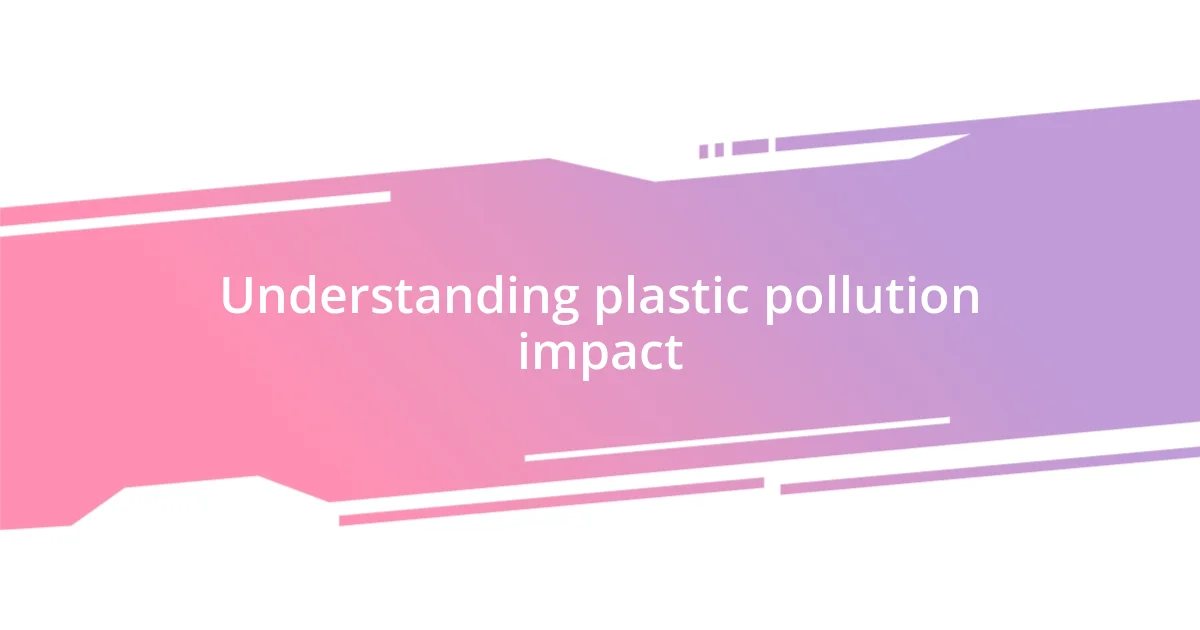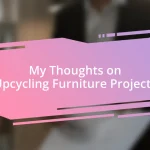Key takeaways:
- Recognizing the pervasive impact of plastic pollution on health and ecosystems encourages personal responsibility and sustainable choices.
- Transforming daily habits by identifying plastic sources at home and replacing them with sustainable alternatives fosters a more eco-friendly lifestyle.
- Engaging the entire household in sustainability initiatives and tracking progress collectively strengthens commitment and awareness of reducing plastic waste.

Understanding plastic pollution impact
Plastic pollution is more than just an environmental issue; it strikes at the very heart of our health and ecosystems. I remember visiting a beach where I was shocked to discover that much of the sand was mixed with tiny plastic pellets. It made me wonder—how did we let it get this far? Each piece of plastic we encounter tells a story, impacting not only marine life but also our own well-being.
Consider how plastic affects wildlife. I’ve seen heartbreaking images of sea turtles entangled in plastic waste, struggling to survive. It’s not just something we hear about; it’s a reality that is unfolding right before our eyes. This connection between our everyday choices and the suffering of innocent creatures is so profound. Don’t you find it hard to ignore?
The longer we wait to tackle plastic pollution, the more severe its consequences become. For instance, did you know that microplastics have been found in our drinking water? This realization hit home for me when I learned that the water I was consuming could be tainted with something we can’t see. It really makes you think about the implications of choosing convenience over sustainability. What legacy are we leaving for future generations?

Identifying plastic sources at home
Identifying the sources of plastic in our homes can feel overwhelming at first. I recall my own experience of doing a mini-inventory around my kitchen. I was surprised to find plastic everywhere—from the packaging of my favorite snacks to the containers I used for food storage. Each item made me realize that it’s not just about what I buy; it’s also about what I choose to keep in my space. Have you ever wondered how much single-use plastic you encounter daily?
One of the primary culprits in the battle against plastic is personal care products. As I sifted through my bathroom cabinet, I discovered shampoo bottles, plastic razors, and even toothpaste tubes that were quietly contributing to the problem. It struck me that the items I often take for granted could be replaced with more sustainable options. How many products have you thought about swapping out for greener alternatives?
As I explored my living area, I noticed plastic decor items and even furniture that I hadn’t considered before. It became clear that while some items are necessary, others were merely adding to the clutter—and the plastic footprint. I began questioning my choices: Do I really need that plastic plant? Understanding where plastic hides can transform how we make purchasing decisions in the future.
| Common Plastic Sources | Alternative Options |
|---|---|
| Food Packaging | Reusable Bags & Containers |
| Personal Care Products | Eco-Friendly Brands |
| Home Decor | Natural Materials |

Choosing sustainable alternatives effectively
Choosing sustainable alternatives effectively can be a fulfilling journey, but it does require a mindful approach. I remember when I first decided to swap out my plastic kitchen sponges. It felt daunting, but finding compostable sponges made me feel like I was contributing to a solution. That small change ignited a sense of purpose in my home, motivating me to look for other replacements. Have you ever experienced that little thrill when you uncover a better choice?
Here’s a list of sustainable alternatives that have become staples in my home:
- Bamboo toothbrushes instead of plastic ones. They’re surprisingly sturdy and biodegradable!
- Glass containers for food storage instead of plastic, which makes me feel like I’m treating my meals with care.
- Beeswax wraps to cover leftovers instead of cling film. They smell amazing and are reusable!
- Cotton produce bags when I shop for fruits and veggies, which add a personal touch to my grocery routine.
Making these choices doesn’t just reduce plastic; it also transforms how I engage with everyday items. Each swap is a step toward a more sustainable lifestyle, and that’s something to celebrate.

Implementing waste reduction strategies
Implementing waste reduction strategies can feel like stitching together a new fabric for your daily life. When I started reducing my plastic waste, one strategy that truly resonated with me was committing to bulk shopping. I remember walking into my local store with my reusable bags, almost bursting with excitement, knowing I could select only what I needed and avoid unnecessary packaging. Did you ever think how empowering it is to choose your quantities and skip the superfluous plastic?
Another effective strategy for me was to establish a routine for assessing my purchases. I found myself setting aside a few minutes each week to consider what I bought, asking: “Can I choose a product with less packaging next time?” This simple reflection turned into a mini ritual. It made me much more conscious of my decisions and opened my eyes to alternatives that I hadn’t previously considered. Have you ever noticed how much easier it is to resist temptation when you pause and think?
Lastly, I made it a point to educate my family about our waste reduction goals. It sparked some engaging conversations around the dinner table, and I was amazed at how motivated my kids became to help. They began suggesting ideas, like organizing a neighborhood clean-up day, which brought us closer together. Just imagine the impact we can have when we make reducing waste a family affair!

Creating reusable products habit
Creating a habit of using reusable products can be an enriching experience. I recall my initial struggle with remembering my reusable bags during grocery store trips. It took a few forgetful outings for me to realize I needed a physical reminder. Now, I keep them right by my front door, and it’s amazing how effortlessly I remember to grab them. Have you ever experienced that moment when a small change makes a big impact on your routine?
Once I established this practice, I discovered that consistent choice builds a stronger habit. For instance, I started using a stainless steel water bottle every day instead of buying plastic bottles. At first, it felt like an added chore, but then I started appreciating the cold water during my long workdays. The shift in mindset from viewing it as a task to valuing the lifestyle change was pivotal. Have you had a product that started as a chore but became a favorite?
Eventually, I expanded my reusable habits to areas I hadn’t considered before. I began keeping cloth napkins on my dining table and even started using them for picnics. The tactile feel of the fabric and the vibrant patterns brought joy to simple moments. I also found it wonderful to talk about these choices with my friends, sharing stories and encouraging each other. How satisfying is it to turn a single action into a network of inspiration?

Engaging household in sustainability
Engaging my household in sustainability was truly a transformative journey. I remember the day I gathered everyone in the living room to brainstorm ways we could reduce our plastic usage. The energy in that room was palpable—it sparked excitement and curiosity. Who would’ve thought that discussing a simple topic like sustainability could turn into a team project? It felt like we were embarking on a mission together, each of us contributing ideas about tiny changes we could make that would collectively add up.
I’ll never forget the day my youngest child declared that we should have a “no-plastic Tuesday,” where we avoided single-use plastics for a whole day. It was heartwarming to watch her enthusiasm as she suggested alternatives—using beeswax wraps instead of plastic cling wrap, or packing lunches in glass containers. It not only taught her the value of our efforts but also made for a fun challenge the whole family looked forward to. Have you ever experienced a family initiative that brought everyone closer together?
One of the best outcomes was witnessing my partner embrace the cause unexpectedly. Initially skeptical, I noticed he started planning more meals that utilized local produce—without plastic packaging! We even made a game of it, turning our visits to the farmers’ market into a scavenger hunt for the freshest items. Each little victory stirred a sense of accomplishment that we could build upon. Isn’t it remarkable how small actions can ripple into greater awareness and motivation?

Tracking progress and challenges
Tracking my progress in reducing plastic at home has been both a rewarding and challenging experience. I started by keeping a journal where I noted my daily choices and the small wins I celebrated, like opting for glass containers over plastic ones. Reflecting on my entries has always given me a sense of accomplishment, but there were hurdles too—on days when I slipped up and forgot my reusable bags, it felt like a step backward. Have you ever had moments where it’s easy to feel discouraged?
Sometimes, the biggest challenge has come from unexpected sources, like my own habits. I realized that even though I was proactive, I still had a tendency to buy snacks packaged in plastic. Breaking that habit meant dedicating time to explore healthier, bulk options, which initially felt like a daunting task. However, I found joy in discovering local shops that offered plastic-free choices. How often do we overlook alternatives right in our own neighborhoods?
Engagement from my family has played a critical role in tracking our collective progress. Together, we created a weekly “Sustainability Sunday” check-in, where we review what worked and where we can improve. I cherish these moments—they remind me that it’s not just about the numbers, but our story as a family evolving towards more mindful choices. Isn’t it amazing how accountability can turn individual efforts into a shared mission?














